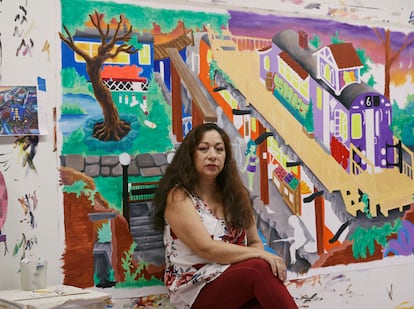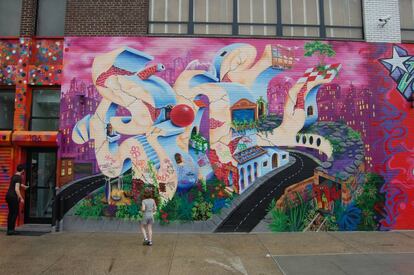Lady Pink, graffiti pioneer: ‘I went through difficult moments, there was a lot of sexism’
She sold her first piece when she was a teenager, met Andy Warhol, collaborated with Jenny Holzer and saw her art reach museums like the Whitney in New York

Lady Pink vividly remembers her first work of graffiti. “I walked across the street from my mom’s house with a couple of my stepdad’s spray cans and did it right there on the front wall of the house. I wrote my boyfriend’s name. They had arrested him for doing graffiti and had sent him to live in Puerto Rico. I cried for him for a month—that’s why I wrote his name,” she recounts via Zoom from her home in the middle of the woods. She lives two hours north of New York, the city that saw her grow up.
She stresses that she doesn’t like anyone—except her family—to call her by her real name, Sandra Fabara. “Lady Pink is the name I chose. I’ve used it for the last 43 years. I find it insulting when they address me another way,” the artist said. She was born in 1964, in Ambato, Ecuador, but was raised in Astoria, Queens. Her neighborhood marked her destiny. At the time, the New York streets were divided between gangs. Graffiti artists had very limited areas in which they could operate.
In the borough of Queens, she began to do graffiti when she was only 15-years-old. She became the first girl to be part of a graffiti gang. “I went through difficult times—there was a lot of sexism, a lot of hostility, but also a lot of acceptance from the boys in my group,” she said. “Crash, Futura, Lee [Quiñones] took me under their wing when I was still in high school and they were 20. They wanted me with them. I know I was a testimonial woman there,” she admitted, “but it was my way of putting my head in that world. I was still an amateur, and I painted with these guys who were the best of the best, celebrities. That made me good. I practiced a lot, I quickly became fast.”
Speed was crucial. Graffiti, she stresses, was—and still is—illegal. “Urban art is a new term. It will take a decade [to become the norm].”
She began painting in tunnels—“It was the most risky, tunnels are very scary”—and trains. Her signature soon became popular, as did her paintings. “I’ve been exhibiting since I was 16. At 21, I had my first solo show at university [at the Moore College of Art], but before that, I had exhibited at the New Museum, at PS1, in galleries. I’ve been a professional artist for years. I sold my first painting at 16.”
“I saw that people were willing to give me money for what I did. Sometimes, on the weekend, I would go with my friends to paint on a train or in a tunnel. Other times, I would go to fancy parties at someone’s house or in a nightclub full of famous people,” she said.
This is how, for instance, she met Andy Warhol. “We were at a party, and he called me and asked me to come talk to him. He was separated from everyone for his safety; I had to get into his circle. I didn’t know what to tell him. He told me that he had seen me in a movie and liked what I did. I had no idea who he was, I was only 17-years-old. I only understood how important he was later on.”
Although her work is now exhibited in museums such as the Whitney Museum of American Art, back then, her priority was street-level: “We graffiti artists were only interested in painting subway cars—that was never done with permission.”
That combination of graffiti and museum pieces is now reflected in her collaboration with Louis Vuitton. Lady Pink is one of the artists chosen for the first edition of White Canvas: LV Trainer in Residence, a project for which she has reinterpreted the emblematic LV Trainer sneakers produced by the French brand. Her creations have been shown in an ephemeral exhibition at Garage Traversi, in Milan, along with those of other artists from the world of graffiti, such as Lee Quiñones and Rammellzee (now deceased).
Virgil Abloh—the late Louis Vuitton artistic director of men’s fashion—was the driving force behind this project. In the first edition, he wanted to pay tribute to the underground New York graffiti scene of the 1980s.
The trainers created by Lady Pink show one of the hallmarks of her work: the brick blocks on which she began to paint as a teenager. “I always use bricks in my work, because we’re muralists. Walls are our thing. A brick is very appropriate for us; it’s where we paint.”
“I’ve done many series in which I’ve used this image. The bricks represent us, the graffiti artists. Many times when I collaborate with large corporations, they dilute our work, soften it for the masses, completely destroy my work… But this hasn’t happened here. I’ve finally collaborated with a company that does it correctly, that doesn’t dilute my work,” she emphasized.
For her, art born in the streets has been an inspiration for fashion for years. “Experts and historians have analyzed it; people paint their jeans, their jackets, they paint everything!” she said.
In this project with Louis Vuitton, Lady Pink has collaborated with one of her first graffiti partners: Lee Quiñones. They had a relationship a long time ago, which was shown in Wild Style, a 1982 film directed by Charlie Ahearn about hip-hop culture and the world of graffiti. Quiñones and Lady Pink play two of the protagonists.

“We had a four-year relationship. The director included everyone in the film, the dancers, the musicians, our love story… I still can’t see it again, it brings back memories of a lot of pain. It was a traumatic relationship. But Lee and I have been doing exhibitions together for over 40 years, so we had to become friends. He gets along with my husband, I adore his wife. He’s the king of graffiti, totally brilliant. He said it was an honor to come back to work with me now.”
Lady Pink believes that Wild Style perpetuated an image of the symbiosis of hip-hop and graffiti that, for her, was wrong. “What that movie did was stereotype me as a hip-hop personality, which I’m not. I don’t like hip-hop, I’m not in that movement… But I’m supposed to be a hip-hop icon,” she said with a wry smile. She said that she’s more into “rock and roll” and added that Missy Elliott is one of the few female rappers she likes.
“At first, everything was a party. But in the nineties, everything turned ugly and in the world of graffiti, everyone had to have an enemy. In music, everyone wanted to be a gangster, and they started treating women in a very disrespectful way. We were just decoration on a man’s arm, they didn’t take us seriously—women were just bitches and hoes,” she said.
“Graffiti existed a decade before hip-hop came along and that, at that time, you only knew about it if you lived in certain neighborhoods. If you lived in white neighborhoods—and a lot of graffiti artists did—you listened to music by Led Zeppelin, Pink Floyd and Metallica,” Lady Pink pointed out.
She followed her own path, always shunning labels. “I was just doing my thing, and they put me in that feminist role, as a role model that represented women, Latinas... I’m just an artist who works,” she said, only to later admit that, when she finds a cause that she believes in, she makes a clear commitment. “Sometimes there are issues that interest me and I do projects. For example, last year I did a job on female reproductive rights. Before that, another on Black Lives Matter. I embrace causes when I think they’re worth it.” She doesn’t do it alone. She has a team of collaborators and her husband is her executive assistant.
“If I empower other women with what I do, I try to, because, unfortunately, women all over the world still need a boost and a helping hand from our sisters. We are not all badass. Some women still need to find confidence and courage. If I can do that for them, it’s worth it.”
She makes it clear that her activism is more actions than words. For example, Lady Pink has been friendly and creatively collaborative with feminist artist Jenny Holzer since they met decades ago. The 1983 portrait of the graffiti artist in Times Square by photographer Lisa Kahane wearing a T-shirt emblazoned with one of Holzer’s slogans—“Abuse of power comes as no surprise” — became iconic.
The works produced by both women are part of collections at the Museum of Modern Art in New York. Their latest collaboration is very recent; it can be seen in the exhibition on Holzer’s work that opened at the K21 museum in Düsseldorf at the beginning of March. “I haven’t been able to travel there, we’ve worked remotely. A few weeks ago, I also painted a large mural in London. My next project is a seven-story hotel in Miami, with a giant brick woman, as if she were the guardian of the city.”
All these projects are carried out from her house. It’s surrounded by trees—she moved there precisely because of the graffiti. She said that a police squad fighting vandalism in the streets made her leave the Big Apple. “They came to my house in 2003 and 2013 and left me clean—they took everything, books, photos, paint sprays, computers... They are known as the ‘graffiti police.’ They had no solid charges, but they broke into the house and accused us. They just hate us. The police have gotten so involved in our lives… That’s why I came to live in the countryside, because they have no jurisdiction here and if they get into my house, they need solid evidence.”
She proudly adds that she has never been arrested for graffiti. “We were going to the right places at the right time. This is how you do it. It’s almost like a military maneuver—everyone knows exactly where to go. There was a leader: each person did their thing, and ran when they were told to.”
Sign up for our weekly newsletter to get more English-language news coverage from EL PAÍS USA Edition
Tu suscripción se está usando en otro dispositivo
¿Quieres añadir otro usuario a tu suscripción?
Si continúas leyendo en este dispositivo, no se podrá leer en el otro.
FlechaTu suscripción se está usando en otro dispositivo y solo puedes acceder a EL PAÍS desde un dispositivo a la vez.
Si quieres compartir tu cuenta, cambia tu suscripción a la modalidad Premium, así podrás añadir otro usuario. Cada uno accederá con su propia cuenta de email, lo que os permitirá personalizar vuestra experiencia en EL PAÍS.
¿Tienes una suscripción de empresa? Accede aquí para contratar más cuentas.
En el caso de no saber quién está usando tu cuenta, te recomendamos cambiar tu contraseña aquí.
Si decides continuar compartiendo tu cuenta, este mensaje se mostrará en tu dispositivo y en el de la otra persona que está usando tu cuenta de forma indefinida, afectando a tu experiencia de lectura. Puedes consultar aquí los términos y condiciones de la suscripción digital.
More information
Archived In
Últimas noticias
Welcome to the post-religion era: The idea of Christianity as the absolute truth has become obsolete
‘I thought you would like it’: The risky sexual practice popularized by TV shows and TikTok
The digitalization of tourism: ‘They promise experiences and gave us the worst possible one’
Mexican peso defies uncertainty with forecasts of a new period of stability in 2026
Most viewed
- Sinaloa Cartel war is taking its toll on Los Chapitos
- Oona Chaplin: ‘I told James Cameron that I was living in a treehouse and starting a permaculture project with a friend’
- Reinhard Genzel, Nobel laureate in physics: ‘One-minute videos will never give you the truth’
- Why the price of coffee has skyrocketed: from Brazilian plantations to specialty coffee houses
- Silver prices are going crazy: This is what’s fueling the rally










































